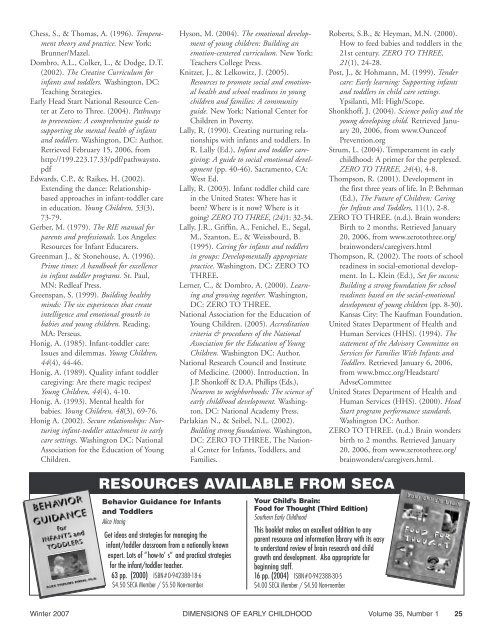Dimensions of Early Childhood - Southern Early Childhood ...
Dimensions of Early Childhood - Southern Early Childhood ...
Dimensions of Early Childhood - Southern Early Childhood ...
Create successful ePaper yourself
Turn your PDF publications into a flip-book with our unique Google optimized e-Paper software.
Chess, S., & Thomas, A. (1996). Temperament<br />
theory and practice. New York:<br />
Brunner/Mazel.<br />
Dombro, A.L., Colker, L., & Dodge, D.T.<br />
(2002). The Creative Curriculum for<br />
infants and toddlers. Washington, DC:<br />
Teaching Strategies.<br />
<strong>Early</strong> Head Start National Resource Center<br />
at Zero to Three. (2004). Pathways<br />
to prevention: A comprehensive guide to<br />
supporting the mental health <strong>of</strong> infants<br />
and toddlers. Washington, DC: Author.<br />
Retrieved February 15, 2006, from<br />
http://199.223.17.33/pdf/pathwaysto.<br />
pdf<br />
Edwards, C.P., & Raikes, H. (2002).<br />
Extending the dance: Relationshipbased<br />
approaches in infant-toddler care<br />
in education. Young Children, 53(3),<br />
73-79.<br />
Gerber, M. (1979). The RIE manual for<br />
parents and pr<strong>of</strong>essionals. Los Angeles:<br />
Resources for Infant Educarers.<br />
Greenman J., & Stonehouse, A. (1996).<br />
Prime times: A handbook for excellence<br />
in infant toddler programs. St. Paul,<br />
MN: Redleaf Press.<br />
Greenspan, S. (1999). Building healthy<br />
minds: The six experiences that create<br />
intelligence and emotional growth in<br />
babies and young children. Reading,<br />
MA: Perseus.<br />
Honig, A. (1985). Infant-toddler care:<br />
Issues and dilemmas. Young Children,<br />
44(4), 44-46.<br />
Honig, A. (1989). Quality infant toddler<br />
caregiving: Are there magic recipes?<br />
Young Children, 44(4), 4-10.<br />
Honig, A. (1993). Mental health for<br />
babies. Young Children, 48(3), 69-76.<br />
Honig A. (2002). Secure relationships: Nurturing<br />
infant-toddler attachment in early<br />
care settings. Washington DC: National<br />
Association for the Education <strong>of</strong> Young<br />
Children.<br />
Hyson, M. (2004). The emotional development<br />
<strong>of</strong> young children: Building an<br />
emotion-centered curriculum. New York:<br />
Teachers College Press.<br />
Knitzer, J., & Lelkowitz, J. (2005).<br />
Resources to promote social and emotional<br />
health and school readiness in young<br />
children and families: A community<br />
guide. New York: National Center for<br />
Children in Poverty.<br />
Lally, R. (1990). Creating nurturing relationships<br />
with infants and toddlers. In<br />
R. Lally (Ed.), Infant and toddler caregiving:<br />
A guide to social emotional development<br />
(pp. 40-46). Sacramento, CA:<br />
West Ed.<br />
Lally, R. (2003). Infant toddler child care<br />
in the United States: Where has it<br />
been? Where is it now? Where is it<br />
going? ZERO TO THREE, (24)1: 32-34.<br />
Lally, J.R., Griffin, A., Fenichel, E., Segal,<br />
M., Szanton, E., & Weissbourd, B.<br />
(1995). Caring for infants and toddlers<br />
in groups: Developmentally appropriate<br />
practice. Washington, DC: ZERO TO<br />
THREE.<br />
Lerner, C., & Dombro, A. (2000). Learning<br />
and growing together. Washington,<br />
DC: ZERO TO THREE.<br />
National Association for the Education <strong>of</strong><br />
Young Children. (2005). Accreditation<br />
criteria & procedures <strong>of</strong> the National<br />
Association for the Education <strong>of</strong> Young<br />
Children. Washington DC: Author.<br />
National Research Council and Institute<br />
<strong>of</strong> Medicine. (2000). Introduction. In<br />
J.P. Shonk<strong>of</strong>f & D.A. Phillips (Eds.),<br />
Neurons to neighborhoods: The science <strong>of</strong><br />
early childhood development. Washington,<br />
DC: National Academy Press.<br />
Parlakian N., & Seibel, N.L. (2002).<br />
Building strong foundations. Washington,<br />
DC: ZERO TO THREE, The National<br />
Center for Infants, Toddlers, and<br />
Families.<br />
Roberts, S.B., & Heyman, M.N. (2000).<br />
How to feed babies and toddlers in the<br />
21st century. ZERO TO THREE,<br />
21(1), 24-28.<br />
Post, J., & Hohmann, M. (1999). Tender<br />
care: <strong>Early</strong> learning: Supporting infants<br />
and toddlers in child care settings.<br />
Ypsilanti, MI: High/Scope.<br />
Shonkh<strong>of</strong>f, J. (2004). Science policy and the<br />
young developing child. Retrieved January<br />
20, 2006, from www.Ounce<strong>of</strong><br />
Prevention.org<br />
Strum, L. (2004). Temperament in early<br />
childhood: A primer for the perplexed.<br />
ZERO TO THREE, 24(4), 4-8.<br />
Thompson, R. (2001). Development in<br />
the first three years <strong>of</strong> life. In P. Behrman<br />
(Ed.), The Future <strong>of</strong> Children: Caring<br />
for Infants and Toddlers, 11(1), 2-8.<br />
ZERO TO THREE. (n.d.). Brain wonders:<br />
Birth to 2 months. Retrieved January<br />
20, 2006, from www.zerotothree.org/<br />
brainwonders/caregivers.html<br />
Thompson, R. (2002). The roots <strong>of</strong> school<br />
readiness in social-emotional development.<br />
In L. Klein (Ed.), Set for success:<br />
Building a strong foundation for school<br />
readiness based on the social-emotional<br />
development <strong>of</strong> young children (pp. 8-30).<br />
Kansas City: The Kaufman Foundation.<br />
United States Department <strong>of</strong> Health and<br />
Human Services (HHS). (1994). The<br />
statement <strong>of</strong> the Advisory Committee on<br />
Services for Families With Infants and<br />
Toddlers. Retrieved January 6, 2006,<br />
from www.bmcc.org/Headstart/<br />
AdvseCommttee<br />
United States Department <strong>of</strong> Health and<br />
Human Services (HHS). (2000). Head<br />
Start program performance standards.<br />
Washington DC: Author.<br />
ZERO TO THREE. (n.d.) Brain wonders<br />
birth to 2 months. Retrieved January<br />
20, 2006, from www.zerotothree.org/<br />
brainwonders/caregivers.html.<br />
RESOURCES AVAILABLE FROM SECA<br />
Behavior Guidance for Infants<br />
and Toddlers<br />
Alice Honig<br />
Get ideas and strategies for managing the<br />
infant/toddler classroom from a nationally known<br />
expert. Lots <strong>of</strong> “how-to’ s” and practical strategies<br />
for the infant/toddler teacher.<br />
63 pp. (2000) ISBN#O-942388-18-6<br />
$4.50 SECA Member / $5.50 Non-member<br />
Your Child’s Brain:<br />
Food for Thought (Third Edition)<br />
<strong>Southern</strong> <strong>Early</strong> <strong>Childhood</strong><br />
This booklet makes an excellent addition to any<br />
parent resource and information library with its easy<br />
to understand review <strong>of</strong> brain research and child<br />
growth and development. Also appropriate for<br />
beginning staff.<br />
16 pp. (2004) ISBN#O-942388-30-5<br />
$4.00 SECA Member / $4.50 Non-member<br />
Winter 2007 DIMENSIONS OF EARLY CHILDHOOD Volume 35, Number 1 25

















